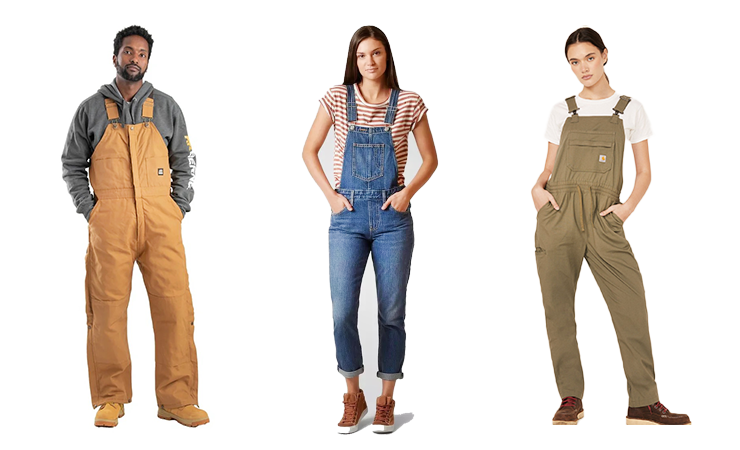
In the world of fashion and workwear, terms like “overall,” “coverall,” and “jumpsuit” are often used interchangeably. However, despite some similarities, these garments have distinct characteristics, origins, and purposes. Understanding the difference can help you choose the right outfit for your needs, whether you’re dressing for a casual day out, a professional environment, or a specific occasion.
Overall: A Versatile Wardrobe Staple
Overalls are perhaps the most recognizable of the three. Traditionally, overalls were designed as durable workwear, primarily for farmers and laborers in the late 19th and early 20th centuries. The classic design features a pair of trousers with an attached bib that covers the chest, held up by straps that go over the shoulders.
While they were originally made from sturdy materials like denim or canvas, overalls have evolved into a fashion staple worn by people of all ages and backgrounds. Today, they come in various fabrics, from lightweight cotton to corduroy, and are available in a range of colors and patterns.
Overalls offer versatility in styling. You can wear them over a t-shirt for a casual look or layer them over a sweater during cooler months. They are often seen in both men’s and women’s wardrobes, with some variations tailored specifically for different body types. The relaxed fit and functional pockets make them both comfortable and practical.
In fashion, overalls have become iconic, with brands like “Levi’s” and “Carhartt” elevating them from mere workwear to a trendy garment that can be worn in a variety of settings. Their laid-back, retro vibe has made them a favorite among fashion-forward individuals.
Coverall: The Functional Workwear
Coveralls, on the other hand, are more utilitarian and are primarily associated with industrial and manual labor jobs. Unlike overalls, coveralls are a one-piece garment that covers the entire body, including the arms and legs. They are often used in professions that require protection from dirt, debris, or hazardous materials, such as mechanics, construction workers, and firefighters.
Coveralls are designed for functionality. They typically feature a zippered or buttoned front closure, and they are made from durable materials like cotton, polyester blends, or flame-resistant fabrics. Some coveralls are even insulated for cold weather conditions or made with reflective strips for enhanced visibility in low-light environments.
The main purpose of coveralls is protection. They act as a barrier between the worker and their environment, keeping clothes underneath clean and safe from potential hazards. This is why coveralls are more commonly found in blue-collar industries and are often provided as part of a uniform.
While not traditionally seen as a fashion item, coveralls have made their way into street style and high fashion in recent years. Designers have reimagined the workwear aesthetic, creating sleek, stylish versions that can be worn as everyday clothing. However, their practical roots remain central to their design.
Jumpsuit: The Fashion-Forward Choice
The jumpsuit is perhaps the most fashion-oriented of the three. Like coveralls, jumpsuits are a one-piece garment that covers both the torso and legs, but they are designed with a more stylish intent. Jumpsuits come in a variety of styles, ranging from casual, loose-fitting designs to more structured, tailored silhouettes suitable for formal occasions.
The jumpsuit first gained popularity in the 1960s and 70s, thanks to its futuristic look and easy, all-in-one design. Since then, it has remained a staple in the fashion world, with designers constantly reinventing the garment in new fabrics, cuts, and patterns. From denim and cotton to silk and satin, jumpsuits can be found in an array of materials, making them suitable for day or night wear.
One of the key features of a jumpsuit is its versatility. It can be dressed up with heels and accessories for an evening event or worn casually with sneakers for a more relaxed look. Unlike overalls or coveralls, jumpsuits often emphasize style over practicality, making them a go-to choice for those who want a fashion-forward outfit with minimal effort.
In recent years, jumpsuits have also become popular in bridal fashion, with modern brides opting for sleek, white jumpsuits as an alternative to traditional wedding dresses. The garment’s ability to make a bold statement while remaining effortlessly chic has solidified its place in contemporary fashion.
While overalls, coveralls, and jumpsuits may share similarities as one-piece garments, their differences lie in their function, design, and purpose. Overalls offer a versatile, casual option with workwear roots, coveralls prioritize protection and functionality in industrial settings, and jumpsuits bring a stylish, fashion-forward edge to any wardrobe. Whether you’re dressing for a day at work or a night out, understanding these differences can help you choose the right outfit for the occasion.
The post Overall, Coverall, and Jumpsuit. What is the Difference? appeared first on The Fashiongton Post.
